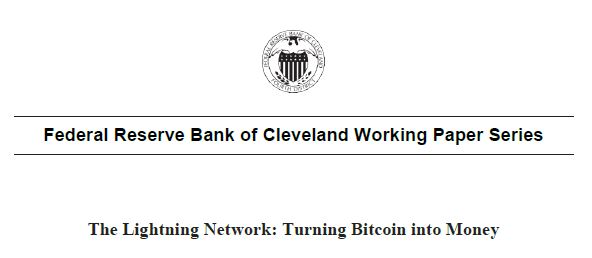[ad_1]
Bitcoin is the FED’s new favorite subject. Fresh from the Federal Reserve Bank of St. Louis measuring inflation in BTC terms, comes the Federal Reserve Bank of Cleveland with a study titled “The Lightning Network: Turning Bitcoin into Money.” A thorough investigation that unfortunately only “covers the period January 1, 2017, to September 5, 2019,” their conclusions are far from surprising.
“We find a significant association between LN adoption and reduced blockchain congestion, suggesting that the LN has helped improve the efficiency of Bitcoin as a means of payment. This improvement cannot be explained by other factors, such as changes in demand or the adoption of SegWit.”
What’s surprising here, though, is that the FED is looking into bitcoin’s Lightning Network. And has positive things to say about it. What exactly is going on here? Let’s check what they found to see if it gives us any clues.

BTC price chart for 07/14/2022 on Timex | Source: BTC/USD on TradingView.com
The FED’s Most Interesting Observations
- “We find that adoption of the Lightning Network has led to a reduction in Bitcoin blockchain congestion and lower mining fees.”
Well FED, that’s exactly the objective. Could the “lower mining fees” affect the project in the long run as altcoin fanatics love to say? Maybe in 50 to 100 years. For now, the miners’ rewards are guaranteed.
- “We find limited evidence that greater centralization of the network is associated with lower fees.”
Good to know, FED!
- “Recent episodes of high congestion, especially in early 2021, suggest that the LN is not a panacea.”
In this study, every little sentence is sourced… except for this one. Why is that, FED?
- “Less blockchain congestion may mean lower barriers to arbitrage across cryptocurrency exchanges, thereby improving market liquidity.”
Notice the “may” there, this is not guaranteed. And it’s the least interesting thing about The Lightning Network.
- “Bertucci studies a strategic model of network formation and shows that competition between nodes prevents the network from becoming highly centralized.”
Take that, altcoiners! Even the FED knows how terrible the “The Lightning Network is centralized” argument is. However…
- “When the network is more centralized, each channel, and each Bitcoin locked into the protocol, is likely to support a higher volume of payments”
Good to know, FED. Nobody wants or needs centralization, though.
Observations About The Bitcoin Network As A Whole
- “Total fees attached to payments waiting in the mempool have fallen since 2017, suggesting either lower demand or greater supply of settlement capacity.”
- “Generally, fees have fallen in nominal bitcoin terms.”
No further comments on these ones.
Questionable Observations In The FED’s Study
- “By reducing fees, the LN reduces the incentive for Bitcoin miners to use large amounts of computing power, meaning less energy use and positive consequences for the environment.”
The Lightning Network implies a much much much lower energy consumption because it doesn’t require mining. However, the bitcoin network and PoW mining is the environment’s best friend, as this other study clearly shows.
- “While this paper focuses on Bitcoin, the same technology can allow other cryptocurrencies to be widely used, secure, and decentralized.”
Stop it, FED. The bitcoin network is the only decentralized one. Altcoins can be many things, but decentralized isn’t one of them.
The Study’s Unsurprising Results
- “Our results suggest that the Lightning Network can help Bitcoin achieve greater scalability, allowing it to operate better as a payments system.”
Once again, that’s exactly the objective. It’s good that even the FED admits that it works as intended, though.
- “An increase in the number of LN channels reduces the mempool count.”
It’s good to remember that both channels and network capacity are at an all-time high.
- “Network centralization does not have a clear effect on the efficiency of the network.”
Good, but nobody wants centralization anyway.
- “If, during 2017, the LN had existed and been the size it was at the end of our sample, by how much would Bitcoin congestion have been lowered? Our results suggest that the mempool count would have been 93 percent lower, mempool fees 96 percent lower, and the proportion of low fee transactions 197 percent higher.”
Those are promising numbers, to say the least.
- “Our findings suggest that the off-chain netting benefits of the Lightning Network can help Bitcoin to scale and function better as a means of payment.”
Even the FED knows this.
- “Data are not available on how Bitcoin is used, so we cannot say for sure whether Bitcoin is being increasingly used as a means of payment.”
It is, though. And the party is just getting started.
- “The Lightning Network loosens a key technological constraint by allowing payments to be settled more quickly.”
Yep, that’s exactly the objective.
And that’s it. It’s crazy how this FED study and the previously analyzed blog post arrived at such different conclusions. Are we dealing with a good cop/ bad cop situation here?
Featured Image: The FED's study cover image | Charts by TradingView

[ad_2]
Source link



